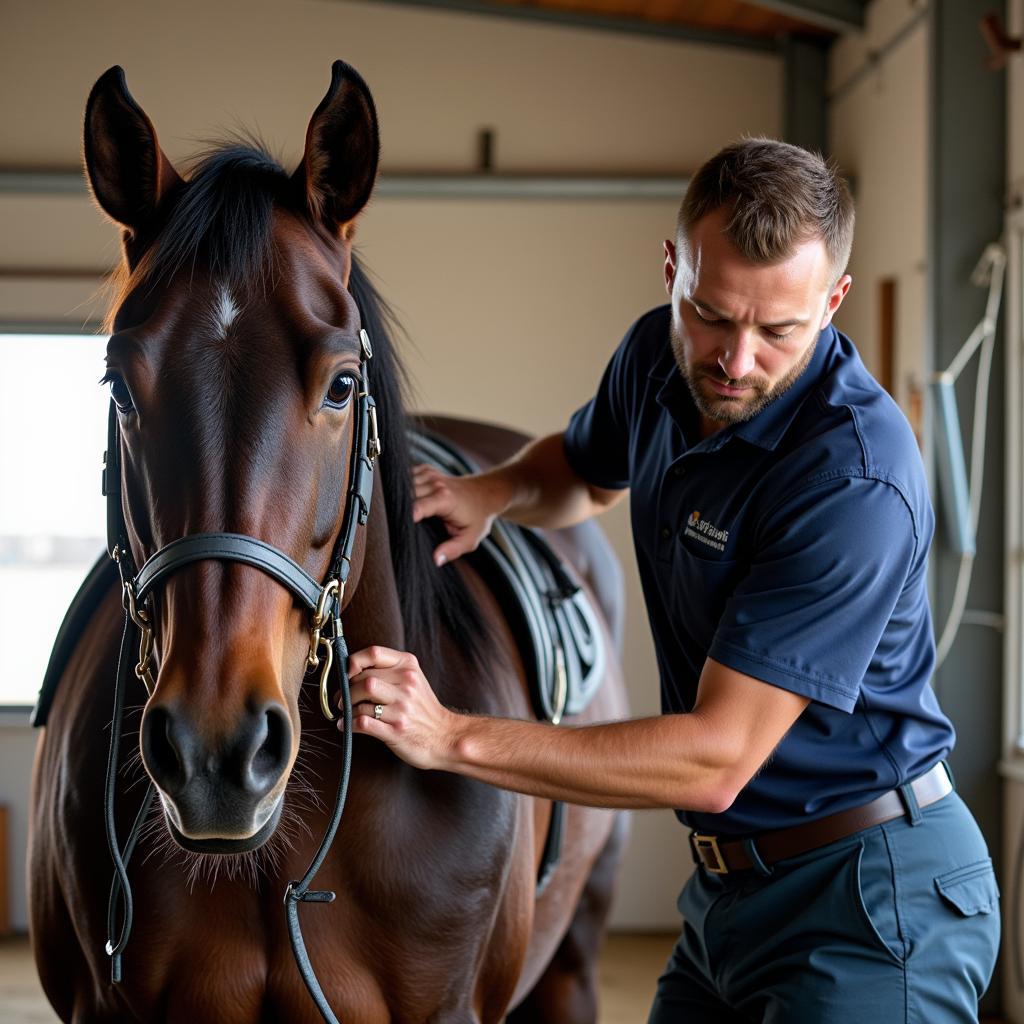ATP, or adenosine triphosphate, is a molecule that plays a critical role in energy production within all living cells, including those of your horse. Often referred to as the “energy currency of life,” ATP provides the fuel for muscle contractions, nerve impulses, and countless other biological processes. Understanding how ATP powers your horse, particularly during periods of intense activity, can provide valuable insight into their athletic performance and overall well-being.
 Structure of an ATP Molecule
Structure of an ATP Molecule
How ATP Works in Horses
Within your horse’s muscle cells, ATP is constantly being broken down and regenerated to provide a continuous energy supply. When a molecule of ATP is broken down, it releases energy and forms adenosine diphosphate (ADP) and a free phosphate group (Pi). This energy powers muscle contraction, allowing your horse to move with power and agility.
The process of regenerating ATP from ADP and Pi requires energy, which is obtained from the breakdown of fuels such as carbohydrates, fats, and, to a lesser extent, protein. Your horse’s diet, training regimen, and overall health status all influence the efficiency of ATP production and utilization.
ATP and Equine Athletic Performance
During intense exercise, the demand for ATP in your horse’s muscles increases dramatically. The horse’s body must rapidly generate ATP to sustain performance. The primary pathways for ATP production during exercise are:
- The Phosphocreatine (PCr) System: This system provides a rapid burst of energy for short, intense efforts, such as sprinting or jumping. However, PCr stores are limited and depleted quickly.
- Anaerobic Glycolysis: This pathway produces ATP from glucose (sugar) without the need for oxygen. It is the primary energy source for moderate to high-intensity exercise lasting a few minutes. Lactic acid, a byproduct of anaerobic glycolysis, can build up in muscles, leading to fatigue.
- Aerobic Respiration: This is the most efficient pathway for ATP production and utilizes oxygen to break down glucose, fats, and protein for energy. Aerobic respiration is the dominant energy system during low to moderate-intensity exercise and for prolonged periods of work.
Optimizing ATP Production in Your Horse
Several factors can influence ATP production and utilization in horses. By understanding these factors, you can help your equine companion perform at their best:
- Nutrition: A balanced diet that provides adequate calories, carbohydrates, fats, and protein is essential for optimal ATP production.
- Hydration: Water plays a vital role in many metabolic processes, including ATP synthesis. Dehydration can significantly impair performance.
- Fitness Level: Regular exercise training improves the efficiency of ATP production and utilization, allowing horses to sustain higher workloads for longer durations.
- Rest and Recovery: Adequate rest allows for the replenishment of energy stores, including ATP and glycogen (stored glucose).
- Supplementation: Certain supplements, such as creatine and electrolytes, may be beneficial in supporting ATP production and recovery.
 Veterinarian Examining a Horse
Veterinarian Examining a Horse
Understanding “ATP Power Horse” Supplements
The term “Atp Power Horse” is often used in marketing for equine supplements that claim to enhance energy production and performance. While these supplements may contain ingredients intended to support ATP production, it’s crucial to approach such claims with a discerning eye.
When evaluating “ATP power horse” supplements, consider the following:
- Ingredients: Look for supplements with scientifically-backed ingredients known to support energy metabolism, such as creatine, B vitamins, or electrolytes.
- Dosage and Quality: Ensure the supplement provides appropriate dosages of active ingredients and is manufactured by a reputable company.
- Individual Needs: Consult with your veterinarian to determine if an “ATP power horse” supplement is right for your horse’s specific needs and training regimen.
Conclusion
ATP is the fundamental energy source that fuels your horse’s every move. By understanding the factors that influence ATP production and utilization, you can make informed decisions regarding your horse’s nutrition, training, and overall management to support their athletic endeavors and well-being.
While “ATP power horse” supplements may offer potential benefits, it’s essential to approach these products with a critical mindset and consult with your veterinarian to determine the best course of action for your equine companion.
FAQs
1. What are the signs of fatigue in a horse?
Signs of fatigue in a horse can include:
- Reluctance to move forward
- Elevated respiratory rate
- Increased heart rate
- Muscle tremors
- Stumbling or incoordination
2. Can I give my horse human energy drinks or supplements?
No, it is not safe to give your horse human energy drinks or supplements. These products may contain ingredients that are toxic to horses.
3. How can I improve my horse’s stamina?
Improving your horse’s stamina requires a multifaceted approach, including:
- Progressive conditioning program
- Balanced diet
- Proper hydration
- Adequate rest and recovery
4. What role does genetics play in equine athleticism?
Genetics plays a significant role in a horse’s athletic potential, influencing factors such as muscle fiber type and cardiovascular efficiency.
5. How can I monitor my horse’s energy levels?
Monitoring your horse’s heart rate, respiratory rate, and body condition can provide insights into their energy levels and recovery status.
For any questions or concerns about your horse’s health or performance, please contact our team at Justus Horses USA. We are dedicated to providing you with the information and support you need to keep your equine partner happy and healthy.
Need Assistance?
Contact us today!
Phone: 0772127271
Email: [email protected]
Address: QGM2+WX2, Vị Trung, Vị Thuỷ, Hậu Giang, Vietnam
Our dedicated customer support team is available 24/7 to assist you.